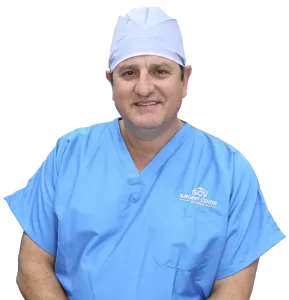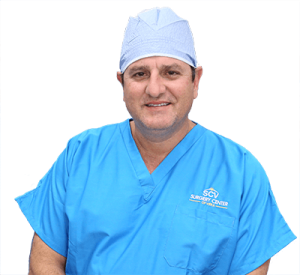
Similar to the filling of a jelly doughnut bursting through a weak spot in the strong outer wall, a herniated disc happens when the gel-like center of a spinal disc does so. When the disc material hits or compresses a spinal nerve, neck, or arm pain, numbness, or tingling may follow.
If you or a loved one is experiencing any of the following symptoms outlined in this article, it’s time to get a FREE Consultation and MRI Review with Deuk Spine Institute. We will help relieve your pain and get you back to living your life without limitations!
The first stage of healing involves rest, painkillers, spinal injections, and physical therapy. Most people get better in six weeks and resume their regular activities. If the symptoms persist, surgery can be suggested.
24-movable bones called vertebrae make up your spine. The cervical (neck) region of the spine supports the roughly 10-pound weight of your head while allowing you to turn your head 180 degrees and bend it forward and backward. The cervical vertebrae range in number from C1 to C7. The discs that separate the vertebrae serve as shock absorbers to keep them from grinding against one another. The annulus is the name for the disc’s outer ring. Each vertebra’s body is connected to it via fibrous bands. The nucleus is the gel-filled inside of each disc.
A pair of spinal nerves emerge from the spinal cord and branch out to your body at each level of the disc. In order to relay sensation and regulate movement, your spinal cord and spinal nerves function as a “telephone,” allowing signals or impulses to pass back and forth between your brain and body.
When a rip forms in the strong disc wall (annulus), the gel-like center of your disc ruptures out, resulting in a herniated disc. Your spinal nerves become irritated by the gel composition, which mimics a chemical irritant. The pressure of the herniated disc on the spinal nerves causes edema and inflammation, which results in discomfort. The herniation usually gets less with time, and you might get some or all pain relief. The average time it takes for neck and/or arm pain to go away is 6 weeks. Through a rip in the disc annulus, the gel-filled nucleus material escapes, compressing the spinal nerve.
A herniated disc may be referred to by various terms. When the disc annulus is intact but develops an outpouching that could rub on the nerves, this is known as a bulging disc (protrusion). The disc annulus must fracture or break for a real herniated disc (also known as a calming-fluid or solid disc) to occur, which then allows the gel-filled center to protrude. A free fragment is when a herniation is sufficiently severe that a component entirely separates from the disc and enters the spinal canal.
Depending on the herniation’s location and how you react to pain, herniated disc symptoms might vary substantially. You can experience pain that travels down your arm and possibly into your hand if you have a herniated cervical disc. Additionally, you can experience pain when rotating your head or bending your neck, as well as soreness around or on your shoulder blade.
Your muscles may spasm occasionally (meaning the muscles tighten uncontrollably). Your arm may occasionally feel tingly and numb in addition to the discomfort. Your biceps, triceps, and handgrip muscles could all be weak. Even though no violent incident that could have resulted in harm occurred, you might have initially felt pain when you woke up. Because this position releases pressure on the nerve, some patients experience relief by holding their arms lifted behind their heads.
Discs can expand or herniate spontaneously, as a result of trauma or incorrect lifting. Aging is a significant factor. Your discs become harder and drier as you age. The disc’s strong fibrous outer wall could deteriorate. When it comes in contact with a nerve, the gel-like nucleus may expand or explode through a tear in the disc wall. Early disc degeneration is caused by genetics, smoking, and a variety of professional and recreational activities.
People in their 30s and 40s are most likely to develop herniated discs, while people in their middle age and later years may be slightly more susceptible if they engage in physically demanding activities. Only 8% of herniated discs happen to be in the neck area.
Consult your primary care physician as soon as you feel any pain. In order to fully understand your symptoms, any prior illnesses or injuries, and any lifestyle choices that may be contributing to the pain, your doctor will take a thorough medical history. A physical examination is next conducted to identify the pain’s cause and check for any muscle weakness or numbness.
One or more imaging tests from the list below may be prescribed by your physician:
A magnetic field and radiofrequency waves are used in a noninvasive examination called an MRI scan to produce a detailed image of your spine’s soft tissues. In contrast to an X-ray, nerves, and discs are easily seen. A dye (contrast agent) may or may not be introduced into your bloodstream during the procedure. An MRI can identify the injured disc and any nerve compression. In addition, it can find malignancies in the spinal cord or abscesses.
A disc herniation between the C4 and C5 vertebrae is visible on an MRI of the side. Signs of spinal stenosis, which is a narrowing of the spinal canal and causes the spinal cord to seem kinked, are also visible.
A myelogram is a specialist X-ray in which a spinal tap is used to infuse dye into the spinal canal. The images produced by the dye are then captured using X-ray fluoroscopy. The myelogram dye appears white on the X-ray, giving the doctor a clear picture of the spinal cord and canal. Myelograms can reveal spinal abscesses, tumors of the spinal cord, bony overgrowth, and pinched nerves caused by herniated discs. This examination could be followed by a CT scan.
A computer and an X-ray beam are used in a noninvasive test called a computed tomography (CT) scan to create two-dimensional images of your spine. A dye (contrast agent) may or may not be introduced into your bloodstream during the procedure. This examination is very helpful for identifying the damaged disc.
Nerve conduction studies (NCS) and electromyography (EMG) examinations track the electrical activity in your muscles and nerves. Your muscles are probed with tiny needles or electrodes, and the results are recorded on a specialized device. A herniated disc puts pressure on the nerve root, making it impossible for the nerve to normally provide the muscle with feeling and action. These examinations can identify muscular weakness and nerve injury.
X-rays show your spine’s bony vertebrae, and they can show your doctor if any of them are too close together or if you have fractures, bone spurs, or arthritic changes. This test by itself is unable to identify a herniated disc.
The first phase in rehabilitation is a conservative nonsurgical treatment, which might include medication, rest, massage, physical therapy, at-home exercises, hydrotherapy, chiropractic adjustments, and pain management. Over 95% of patients with arm discomfort brought on by a herniated disc see improvement and resume normal activities in around six weeks. Your doctor could advise surgery if you don’t respond to conservative treatment or if your symptoms worsen.
non-surgical procedures
Self-care: In most situations, the pain from a herniated disc will lessen over the course of a few days and eventually go away in about four to six weeks. Your recovery will be aided by activity limitations, ice/heat therapy, and the use of over-the-counter drugs.
Steroid injections: During the treatment, which is carried out under x-ray fluoroscopy, steroids and a numbing agent are injected into the spine’s epidural area. To lessen the swelling and irritation of the nerves, the medication is administered just adjacent to the painful location.
After receiving an epidural injection, about 50% of patients report feeling better, however, the effects are frequently transient. To get the full impact, you may need to administer the injections again. Pain alleviation can continue for weeks or years, depending on the individual.
Injections are administered in tandem with a home exercise program and/or physical therapy.
Physical therapy: The purpose of physical therapy is to assist you in quickly returning to full activity and avoiding re-injury. Physical therapists can teach you the right ways to walk, lift objects, and stand, as well as how to stretch and strengthen your neck, shoulder, and arm muscles. Additionally, they will exhort you to stretch and improve the flexibility of your arms and spine. Exercise and strengthening activities are essential components of your treatment and ought to be incorporated into your lifelong fitness regimen. Therapies that address the whole person: Some patients find that acupuncture, acupressure, yoga, dietary adjustments, meditation, and biofeedback are effective in treating pain and enhancing general health.
Surgery may be a possibility if symptoms worsen or do not get better with conservative care. Surgery planning takes into account a number of variables, including the patient’s age, the length of time the issue has lasted, additional health issues, prior neck procedures, and projected results.
Clinical trials are research projects in which novel therapies, including medicines, tests, operations, and other therapies, are tried on humans to determine their efficacy and safety. Research is constantly being done to raise the bar for medical care. On the Internet, you can find details on current clinical studies, such as eligibility requirements, protocol details, and locations.
Eight out of ten people experience back discomfort at some point in their life, and it often goes away within six weeks. Recovering requires a healthy outlook, consistent exercise, and a fast return to work, among other things. It is to your best advantage to return to a modified (light or restricted) duty if your usual job cannot be done at first. Such activities may be prescribed by your doctor for brief periods of time.
The Deuk Spine Institute encourages and welcomes you to contact us today regarding any questions or concerns you may have regarding your current situation.
If you or someone you love is experiencing any of the preceding symptoms outlined, it is imperative to get a FREE Consultation and MRI Review with the Deuk Spine Institute. We can help relieve your pain and get you back to living your life without limitations!

